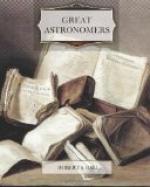“As genius and destiny have joined the names of Le Verrier and Adams, I shall by no means put them asunder; nor will they ever be pronounced apart so long as language shall celebrate the triumphs Of science in her sublimest walks. On the great discovery of Neptune, which may be said to have surpassed, by intelligible and legitimate means, the wildest pretensions of clairvoyance, it Would now be quite superfluous for me to dilate. That glorious event and the steps which led to it, and the various lights in which it has been placed, are already familiar to every one having the least tincture of science. I will only add that as there is not, nor henceforth ever can be, the slightest rivalry on the subject between these two illustrious men—as they have met as brothers, and as such will, I trust, ever regard each other—we have made, we could make, no distinction between then, on this occasion. May they both long adorn and augment our science, and add to their own fame already so high and pure, by fresh achievements.”
Adams was elected a Fellow of St. John’s College, Cambridge, in 1843; but as he did not take holy orders, his Fellowship, in accordance with the rules then existing came to an end in 1852. In the following year he was, however, elected to a Fellowship at Pembroke College, which he retained until the end of his life. In 1858 he was appointed Professor of Mathematics in the University of St. Andrews, but his residence in the north was only a brief one, for in the same year he was recalled to Cambridge as Lowndean Professor of Astronomy and Geometry, in succession to Peacock. In 1861 Challis retired from the Directorship of the Cambridge Observatory, and Adams was appointed to succeed him.
The discovery of Neptune was a brilliant inauguration of the astronomical career of Adams. He worked at, and wrote upon, the theory of the motions of Biela’s comet; he made important corrections to the theory of Saturn; he investigated the mass of Uranus, a subject in which he was naturally interested from its importance in the theory of Neptune; he also improved the methods of computing the orbits of double stars. But all these must be regarded as his minor labours, for next to the discovery of Neptune the fame of Adams mainly rests on his researches upon certain movements of the moon, and upon the November meteors.
The periodic time of the moon is the interval required for one circuit of its orbit. This interval is known with accuracy at the present day, and by means of the ancient eclipses the period of the moon’s revolution two thousand years ago can be also ascertained. It had been discovered by Halley that the period which the moon requires to accomplish each of its revolutions around the earth has been steadily, though no doubt slowly, diminishing. The change thus produced is not appreciable when only small intervals of time are considered, but it becomes appreciable when we have to deal with intervals of thousands of




